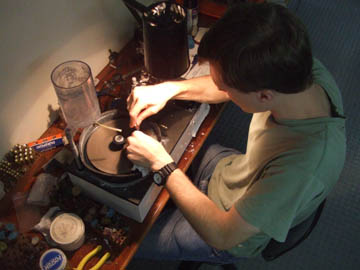John's Tips for Successful Gemstone Faceting
- Gems:
Don't be afraid to start faceting with a large gem. They are easier to cut because mistakes don't happen as quickly and in general it's easier to tell how the gem is developing as you're faceting. Big gems also don't fall off the dop as much.
- Rough:
- Equipment:
Laps: For starting out you should probably have a 360 and a 600 grit "topper" lap (a lap that you put on top of another for support, they are thinner and cheaper), a 600 grit Raytech Nubond lap and a 1200 grit Raytech NuBond lap these will allow you to do most of the kinds of cutting you will want to do. For polishing I recommend the Spectra Ultra laps for the quartz, opal and feldspar groups and for most other gems a Tin lap with Linde A polishing powder. If you are looking to economize and will limit yourself to fewer gem varieties then this list can be made a but shorter but in the long run you will probably want most of these.
Dops: The most useful dops are the cone dops and you might want a few "Vee" dops. Most of the more "exotic" shapes (excluding "emerald dops") aren't that useful.
I personally like to use Dop Wax for the second side of the gem and a kind of clay like epoxy for the first side.
 Odds and Ends: You
will need an alcohol
lamp, lighter and acetone.
You will
also probably want an Optivisor and 10 power
triplet loupe for examining your work. A mm guage is often useful as
well; I like the digital calipers from China that cost about $20.
Odds and Ends: You
will need an alcohol
lamp, lighter and acetone.
You will
also probably want an Optivisor and 10 power
triplet loupe for examining your work. A mm guage is often useful as
well; I like the digital calipers from China that cost about $20.Reference Book: The book "Faceting for Amateurs" by Glenn and Martha Vargas would probably be a good book for a beginner to buy.
